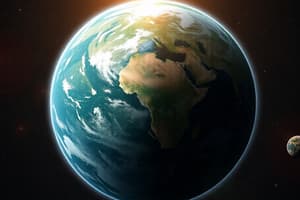Podcast
Questions and Answers
What percentage of the Earth's surface is covered by water?
What percentage of the Earth's surface is covered by water?
70%
Earth is the only habitable planet in the solar system.
Earth is the only habitable planet in the solar system.
True (A)
Which gases primarily compose the Earth's atmosphere?
Which gases primarily compose the Earth's atmosphere?
- Oxygen (correct)
- Helium
- Nitrogen (correct)
- Carbon Dioxide
Earth has four main layers: Crust, Mantle, Outer Core, and _____ Core.
Earth has four main layers: Crust, Mantle, Outer Core, and _____ Core.
What type of rock is formed from the solidification of molten material?
What type of rock is formed from the solidification of molten material?
Match the following types of weathering with their descriptions:
Match the following types of weathering with their descriptions:
What is the process by which rocks break down into sediments called?
What is the process by which rocks break down into sediments called?
Which of the following is an agent of erosion?
Which of the following is an agent of erosion?
Magma is the same as lava.
Magma is the same as lava.
What is metamorphism?
What is metamorphism?
What type of igneous rock is formed below the Earth's surface?
What type of igneous rock is formed below the Earth's surface?
Study Notes
Characteristics of the Earth
- Earth is unique as a terrestrial and ocean planet, covering 70% of its surface with water.
- It is the only known habitable planet, consisting mainly of nitrogen and oxygen.
Comparison to Venus and Mars
- Venus is often referred to as Earth's twin due to similar sizes and compositions.
- Mars is approximately half the size of Earth.
Factors that Make Earth Habitable
- Optimal temperature range sustains life.
- Abundant water is essential for living organisms.
- The atmosphere provides necessary gases for respiration and protection from harmful radiation.
- Nutrients are vital for growth and development of flora and fauna.
- Energy from the sun drives various biological and geological processes.
Subsystems of the Earth
- Geosphere: The land component, including rocks and minerals.
- Hydrosphere: Contains all forms of water, primarily in liquid state.
- Atmosphere: The layer of gases, mainly oxygen and nitrogen, surrounding Earth.
- Biosphere: Encompasses all living organisms.
Layers of the Earth
- Crust: The outermost layer, composed of rocks.
- Mantle: Semi-solid layer beneath the crust.
- Outer Core: Liquid layer composed mainly of iron and nickel.
- Inner Core: Solid center of the Earth, extremely hot and composed of iron.
Rocks and Minerals
- Mineral Definition: A naturally occurring, homogeneous solid with a definite chemical composition and ordered internal structure.
- Physical Properties of Minerals:
- Color or streak indicates mineral identity.
- Luster describes light reflection ability.
- Hardness ranges from soft (talc) to hard (diamond).
- Cleavage refers to the tendency to break along smooth surfaces.
Chemical Composition of Minerals
- Silicate: Compounds of silicon and oxygen.
- Oxides: Minerals used in the paint industry.
- Sulfates: Contain sulfur and oxygen.
- Sulfides: Comprise sulfur combined with metals.
- Carbonates: Minerals containing carbonate ions.
- Native Elements: Pure elemental minerals.
- Halides: Derived from halogen elements.
Types of Rocks
- Igneous Rocks: Formed through the solidification of molten material, classified into:
- Plutonic (intrusive): Solidify below surface.
- Volcanic (extrusive): Solidify at the surface.
- Sedimentary Rocks: Formed from the accumulation, compaction, and cementation of sediments.
- Metamorphic Rocks: Created from existing rocks that undergo metamorphism due to heat and pressure.
Weathering, Erosion, Decomposition
- Weathering: Breakdown of rocks into sediments without movement.
- Types of Weathering:
- Mechanical: Physical breakdown due to pressure, temperature, frost wedging, abrasion, and biological activity.
- Chemical: Involves dissolution, hydrolysis, and oxidation of minerals.
- Erosion: Movement of soil or rock particles by agents such as gravity, wind, water, and glaciers.
Earth’s Sources of Heat
- Primordial Heat: Derived from accretion and bombardment during Earth's formation.
- Radiogenic Heat: Resulting from the decay of radioactive elements (K40, Th232, U235, U238).
- Heat transfer methods include conduction, convection (in the mantle), and radiation (from the sun).
Magma Formation
- Magma: Liquid rock beneath Earth's surface; transforms to lava upon eruption.
- Components of Magma/Lava: Melts, solids, and volatiles.
- Types of Magma:
- Basaltic
- Andesitic
- Rhyolitic: High viscosity and temperature, lighter in color.
Types of Melting
- Decompression Melting: Occurs at mid-ocean ridges where pressure decreases.
- Flux-melting: Involves the addition of water to rock at subduction zones, lowering melting points.
- Heat-induced Melting: Occurs at hotspots due to applied heat.
- Partial Melting: Results in uneven melting within the mantle.
Classification of Igneous Rock by Texture
- Phaneritic: Large, interlocking crystals.
- Aphanitic: Fine-grained texture.
- Porphyritic: Contains phenocrysts with large crystals.
- Vesicular: Characterized by the presence of holes or pores.
- Glassy: Lacks a crystalline structure, e.g., obsidian.
Metamorphism
- Refers to the changes occurring within a rock under heat and pressure.
- Metamorphic Grade: Indicates the conditions under which metamorphism occurs.
- Foliated Metamorphic Rock: Exhibits a striped appearance due to the alignment of mineral grains under pressure.
Studying That Suits You
Use AI to generate personalized quizzes and flashcards to suit your learning preferences.
Related Documents
Description
Explore the unique features that make Earth a distinctive planet among its neighbors, Venus and Mars. This quiz examines Earth's composition, its subsystems such as the geosphere and hydrosphere, and the essential factors contributing to its habitability.



